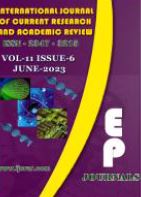Abstract Volume:11 Issue-6 Year-2023 Original Research Articles
 |
Online ISSN : 2347 - 3215 Issues : 12 per year Publisher : Excellent Publishers Email : editorijcret@gmail.com |
2Department of Natural Resource Management, Haramaya University, Haramaya, Ethiopia
Soil test based fertilizer recommendation concurrent to the actual limiting nutrients for a given crop helps to supply adequate and balanced plant nutrients for sustainable crop production without affecting soil health negatively. Blended NPSB fertilizer is a newly introduced fertilizer for crop production in the study area. However their optimum rate for maize crop production is not yet determined in the study area. Therefore, a study was conducted to investigate the effects of blended NPSB fertilizer rates on maize yield and yield components in Bedele district at Banshure Kebele during the 2021main cropping season. The experiment was laid out in randomized complete block design (RCBD) with three replication of the treatments (0, 25, 50, 75, 100, 150, 200, 250 and 300 kg ha-1) of blended NPSB fertilizer rates supplemented with the recommended nitrogen rate for maize production in Bedele District. Selected soil properties before trial were analyzed following standard laboratory procedure at soil laboratory of Bedele Agricultural Research Center. Soil analytical results before planting indicated that, the soils of the research sites had clay textural class, are moderately acidic (5.48 and 5.47), medium in OC content (2.04 and 2.12%), had low TN (0.17 and 0.18%), medium available P (1.67 and 1.77 mg kg-1), low available S (9.26 mg kg-1), low available B (0.3 and 0.36 mg kg-1), medium CEC (20.94 and 22.64 cmol (+) kg-1) and very low PBS (16.85 and 16.29%), for Alle and Abu respectively. The analysis of variance indicated that, the blended NPSB fertilizer rate highly significantly affected maize growth, yield and yield components. Moreover, the result showed that economically feasible grain yield (7173.6 kg ha-1) and net benefit (74897.58 ETB ha-1) with highest marginal rate of return of 2957% were obtained from the plot treated with 150 kg ha-1 of blended NPSB fertilizer rate. Therefore, based on the result obtained from this study, application of 150 kg ha-1 of blended NPSB fertilizer rate and recommended N can be tentatively suggested as economically profitable for the production of maize at the study area.
How to cite this article:
Dechasa Mengistu, Lemma Wogi and Abdissa Bekele. 2023. Effects of Blended NPSB Fertilizer Rates on Maize (Zea mays L) Yield and Yield Components of at Banshure Kebele in Bedele District, South Western Ethiopia.Int.J.Curr.Res.Aca.Rev. 11(6): 34-52doi: https://doi.org/10.20546/ijcrar.2023.1106.004



Quick Navigation
- Print Article
- Full Text PDF
- How to Cite this Article
- on Google
- on Google Scholor
- Citation Alert By Google Scholar
